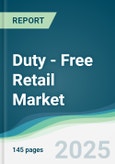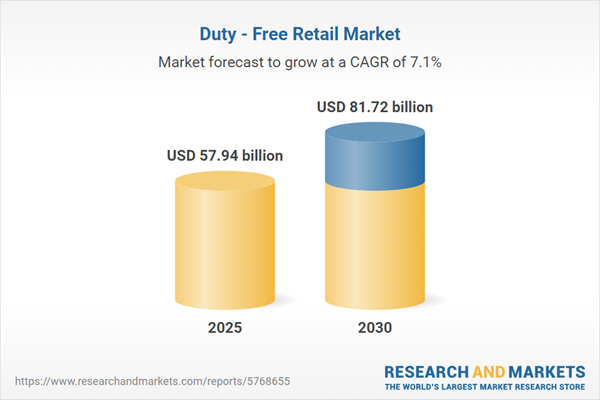The global duty-free retail market is experiencing robust growth, driven by the expansion of global tourism, the development of new transport routes, and increasing consumer demand for luxury and tax-exempt products. Duty-free shops, primarily located in international airports, border shops, cruise ships, and inflight retail, offer merchandise free from regional or national taxes and duties for travelers exporting goods. These outlets are critical to the economic viability of airports and significantly contribute to the travel, tourism, and aviation sectors. Despite challenges from currency volatility impacting demand, the market is propelled by infrastructure investments and rising tourist spending.
Market Drivers
Expansion of Global Tourism and Transport Routes
The growth of global tourism and the establishment of new international transport routes are key drivers of the duty-free retail market. The development of airport infrastructure worldwide supports the proliferation of duty-free shops, enhancing their accessibility and revenue potential. These shops are vital for airports, many of which would operate at a loss without duty-free revenue. The expansion of international travel, particularly post-COVID regulation relaxations, has increased tourist footfall in duty-free outlets, boosting sales of luxury and specialty products.Rising Demand for Luxury Products
Increasing tourist spending on luxury goods is a significant market driver, particularly in regions with high travel activity. Duty-free shops cater to travelers seeking premium products like cosmetics, alcohol, and fashion at tax-exempt prices, driving market growth. The appeal of exclusive, high-end offerings and the convenience of purchasing during travel enhance the market’s attractiveness, especially in airports designed to attract tourists to retail outlets.Market Restraint
Currency Volatility
Currency fluctuations pose a challenge to the duty-free retail market, as shops operate across multiple countries and currencies with varying exchange rates. This volatility creates inconsistency in demand, particularly for luxury products, as exchange rate shifts can positively or negatively impact purchasing power. The unpredictability of global market dynamics affects pricing strategies and consumer behavior, hindering market expansion in some regions.Geographical Outlook
Asia-Pacific
The Asia-Pacific region is anticipated to experience significant growth in the duty-free retail market, driven by its robust tourism industry and strategic initiatives to establish free trade zones. Rising disposable incomes and increasing travel in countries like China and India are boosting demand for duty-free products. The region’s focus on enhancing airport retail experiences and introducing innovative, high-end goods positions it as a key growth hub for the market.Europe
Europe is poised for notable growth, fueled by rising tourist spending on luxury products and the relaxation of travel restrictions. Airports in countries like the United Kingdom, France, and Germany are designed to attract travelers to duty-free outlets, leveraging high footfall to drive sales. The region’s established tourism infrastructure and preference for premium goods support market expansion.North America
North America, led by the United States, is a significant market, driven by high travel spending and a strong tourism sector. The U.S. benefits from an influx of international tourists, boosting duty-free sales in airports. Canada also contributes through its growing network of duty-free shops, supported by cross-border travel and tourism. The region’s focus on luxury retail and airport retail enhancements drives market growth.Market Trends
The duty-free retail market is characterized by a focus on premium and innovative product offerings, catering to travelers’ preferences for luxury goods. The expansion of airport infrastructure and the integration of duty-free shops as key revenue sources for airports are enhancing market accessibility. The relaxation of travel restrictions has increased tourist spending, particularly on high-end products, while strategic initiatives like free trade zones are creating new opportunities for market growth. The market also benefits from the growing popularity of travel retail in non-airport settings, such as cruise ships and border shops.The duty-free retail market is on a strong growth trajectory, driven by global tourism expansion, new transport routes, and rising demand for luxury products. Asia-Pacific leads with its tourism boom and free trade initiatives, while Europe and North America contribute through high tourist spending and robust airport retail. Currency volatility remains a challenge, impacting demand predictability. As airports and travel hubs continue to prioritize duty-free retail as a revenue driver, the market is well-positioned for sustained expansion, catering to the evolving needs of global travelers during the forecast period.
Key Benefits of this Report:
- Insightful Analysis: Gain detailed market insights covering major as well as emerging geographical regions, focusing on customer segments, government policies and socio-economic factors, consumer preferences, industry verticals, and other sub-segments.
- Competitive Landscape: Understand the strategic maneuvers employed by key players globally to understand possible market penetration with the correct strategy.
- Market Drivers & Future Trends: Explore the dynamic factors and pivotal market trends and how they will shape future market developments.
- Actionable Recommendations: Utilize the insights to exercise strategic decisions to uncover new business streams and revenues in a dynamic environment.
- Caters to a Wide Audience: Beneficial and cost-effective for startups, research institutions, consultants, SMEs, and large enterprises.
What do businesses use these reports for?
Industry and Market Insights, Opportunity Assessment, Product Demand Forecasting, Market Entry Strategy, Geographical Expansion, Capital Investment Decisions, Regulatory Framework & Implications, New Product Development, Competitive IntelligenceReport Coverage:
- Historical data from 2022 to 2024 & forecast data from 2025 to 2030
- Growth Opportunities, Challenges, Supply Chain Outlook, Regulatory Framework, and Trend Analysis
- Competitive Positioning, Strategies, and Market Share Analysis
- Revenue Growth and Forecast Assessment of segments and regions including countries
- Company Profiling (Strategies, Products, Financial Information, and Key Developments among others.
Duty-Free Retail Market Segmentation:
By Distribution Channel
- Airports & On-board Aircraft
- Seaports
- Railway Stations
- Border Shops
- Downtown Duty-Free Stores
- Cruise Ships/Ferries
By Product Type
- Cosmetics and Personal Care
- Alcohol
- Tobacco
- Food and Beverages
- Fashion & Accessories
- Confectionery & Gifts
- Electronics
- Others
By Geography
- North America
- USA
- Canada
- Mexico
- South America
- Brazil
- Argentina
- Others
- Europe
- United Kingdom
- Germany
- France
- Spain
- Others
- Middle East and Africa
- Saudi Arabia
- UAE
- Others
- Asia Pacific
- China
- Japan
- India
- South Korea
- Taiwan
- Others
Table of Contents
Companies Mentioned
- Lotte Duty Free
- Lagardère Travel Retail
- DFS Group
- Dubai Duty Free
- Gebr. Heinemann SE & Co. KG
- China Duty Free Group (CDFG)
- Ever Rich Duty Free
- King Power International Group
- Aer Rianta International (ARI)
Table Information
| Report Attribute | Details |
|---|---|
| No. of Pages | 145 |
| Published | August 2025 |
| Forecast Period | 2025 - 2030 |
| Estimated Market Value ( USD | $ 57.94 billion |
| Forecasted Market Value ( USD | $ 81.72 billion |
| Compound Annual Growth Rate | 7.1% |
| Regions Covered | Global |
| No. of Companies Mentioned | 9 |









